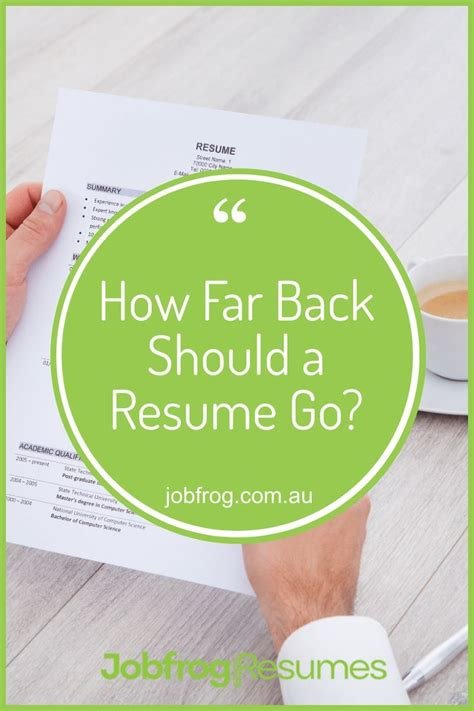Learn how to determine the perfect time frame and relevance for highlighting relevant experience, and understand its impact on your credibility. Improve your SEO strategy today!When it comes to crafting the perfect resume, one of the most common questions job seekers have is how far back they should go in detailing their work experience. Determining the appropriate time frame to include on a resume can be a challenging task, as it requires careful consideration of relevance and the potential impact on the applicant’s credibility. In this blog post, we will delve into this topic by exploring the factors to consider when deciding how far back to go on a resume, the importance of highlighting relevant experience, and the strategies job seekers can employ to effectively showcase their qualifications. Whether you’re a recent graduate entering the workforce or a seasoned professional with years of experience, understanding the best approach to presenting your work history is crucial to landing your next job opportunity. Let’s explore the best practices for determining the optimal time frame to include on your resume.
Determining the Appropriate Time Frame
When it comes to determining the appropriate time frame to include on your resume, it’s important to consider a few key factors. One of the most important things to keep in mind is the relevance of the experience to the job you are applying for. While it may be tempting to include every job you’ve ever had, it’s essential to focus on the roles that are most relevant to the position you are seeking.
Another consideration is the impact of including too much information on your resume. Including irrelevant or outdated experience can detract from the overall impact of your resume and can make it harder for the hiring manager to see your most relevant skills and experience.
Ultimately, the goal is to highlight your most relevant and recent experience in a way that enhances your credibility as an applicant. This means strategically choosing which roles to include and crafting your resume to emphasize the skills and experience that are most valuable to the position you are applying for.
Consideration of Relevance
Consideration of Relevance
When determining how far back to go on a resume, it’s crucial to consider the relevance of each past experience. Relevance is the key factor in deciding which experiences to include and which to leave out. By prioritizing relevant experience, you ensure that your resume effectively communicates your qualifications for the position you’re applying for.
One effective strategy for highlighting relevant experience is to tailor your resume to the specific job description. By emphasizing the skills and accomplishments that are most relevant to the position, you demonstrate to the employer that you are a strong fit for the role. This also helps to showcase your understanding of the company’s needs and how you can contribute to its success.
Ultimately, the consideration of relevance plays a crucial role in shaping the overall impact of your resume. By carefully evaluating the relevance of each past experience and strategically highlighting the most pertinent ones, you can enhance your credibility as an applicant and increase your chances of securing an interview.
Effect on Applicant’s Credibility
Effect on Applicant’s Credibility
One of the most important factors to consider when deciding how far back to go on a resume is the effect on applicant’s credibility. Including too much information from too far back can make it seem like the candidate is desperate to fill space, lacks relevant experience, or is trying to hide something. On the other hand, excluding too much information could make it seem like the applicant is trying to hide gaps in employment or is not fully transparent about their work history. This can greatly affect the credibility of the applicant in the eyes of the employer.
It’s important to strike a balance between showcasing relevant experience and not going too far back in time. One strategy for highlighting relevant experience without including too much outdated information is to focus on the past 10-15 years of work history. This allows the applicant to showcase their most recent and relevant experience without overwhelming the employer with too much information. By focusing on more recent work history, the applicant can demonstrate their current skills and expertise, while still providing a comprehensive overview of their career.
It’s also important for the applicant to carefully consider the relevance of the positions and experiences they include on their resume. Including outdated or irrelevant information can dilute the impact of the resume and make it more difficult for the employer to discern the applicant’s relevant qualifications. By carefully selecting which experiences to include, the applicant can ensure that they are presenting themselves in the best possible light and maintaining their credibility.
Strategies for Highlighting Relevant Experience
When it comes to crafting a resume, the inclusion of relevant experience is vital in capturing the attention of potential employers. One effective strategy for highlighting relevant experience is to utilize the PAR method (Problem, Action, Result) when describing previous job responsibilities. By outlining the specific challenges faced, the actions taken, and the positive results achieved, candidates can effectively demonstrate their ability to make meaningful contributions in future roles.
Another valuable strategy is to tailor the resume for each specific job application. This involves carefully reviewing the job description and aligning the wording and emphasis of the resume to closely match the desired qualifications and responsibilities outlined by the employer. By highlighting experiences that directly relate to the job at hand, candidates can enhance the relevance of their resume and increase the likelihood of being considered for the position.
Additionally, including quantifiable achievements can significantly bolster the impact of relevant experience on a resume. Rather than simply listing job duties, candidates should quantify their accomplishments by including metrics, percentages, or specific data points that illustrate the tangible impact of their contributions. This not only adds credibility to the resume, but also provides insight into the candidate’s ability to produce measurable results within the workplace.
